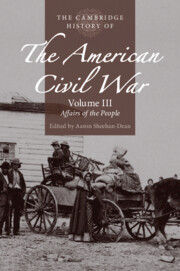Book contents
- The Cambridge History of the American Civil War
- The Cambridge History of the American Civil War
- The Cambridge History of the American Civil War
- Copyright page
- Contents
- Plates
- Figures
- Contributors to Volume III
- Note on the Text
- Part I Values
- Part II Social Experience
- 6 Families in the Civil War
- 7 Refugees and Movement in the Civil War
- 8 Citizen Soldiers
- 9 Immigrant America and the Civil War
- 10 Emancipation and War
- 11 The Black Military Experience
- 12 Motives and Morale
- 13 Urban and Rural America in the Civil War
- Part III Outcomes
- Index
- Plate Section (PDF Only)
- References
10 - Emancipation and War
from Part II - Social Experience
Published online by Cambridge University Press: 11 October 2019
- The Cambridge History of the American Civil War
- The Cambridge History of the American Civil War
- The Cambridge History of the American Civil War
- Copyright page
- Contents
- Plates
- Figures
- Contributors to Volume III
- Note on the Text
- Part I Values
- Part II Social Experience
- 6 Families in the Civil War
- 7 Refugees and Movement in the Civil War
- 8 Citizen Soldiers
- 9 Immigrant America and the Civil War
- 10 Emancipation and War
- 11 The Black Military Experience
- 12 Motives and Morale
- 13 Urban and Rural America in the Civil War
- Part III Outcomes
- Index
- Plate Section (PDF Only)
- References
Summary
Emancipation is the Civil War’s hallmark achievement and most enduring legacy. In many ways, it is the conflict’s distinguishing mark, the silver lining that elevates it from another pointless bloodbath to a just war. Yet while it was taking place, the destruction of Southern slavery was a long-winded, haphazard process, fraught with inconsistencies and suffused with tragedy. At any given moment and at any given place, the fate of emancipation rested on a combination of factors: the particular configuration of slavery in the area, the geographical lay of the land, the balance of power between Union and Confederate forces, the policies of both governments, the individual attitudes of local commanders, and the ability of enslaved people to seize opportunity from these shifting circumstances. On the ground, the war never was a steady march towards freedom, and the collapse of the slave system was marked by great variation across time and space. In some locales, it was quick and sudden, marked by wholesale departures of the enslaved population or by spurts of violence against masters and their property. In others, slavery died a slow and gradual death, with acts of resistance so subtle they were barely visible to the naked eye.
- Type
- Chapter
- Information
- The Cambridge History of the American Civil War , pp. 194 - 219Publisher: Cambridge University PressPrint publication year: 2019



